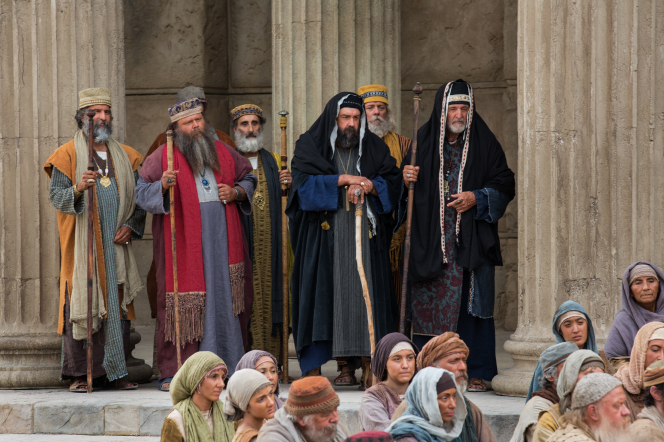Even Jewish rabbis view leaven as symbolizing sin - Jews For Jesus [1]. Let's see how Jesus Himself interpreted leaven. In verse 12 of Matthew 16, Matthew says they (the disciples) understood Jesus was talking about the doctrine of the Pharisees and Sadducees. Well, which is it? Does leaven represent sin or does it represent doctrine? As Grant Luton of Beth Tikkun [2] says, "If a scripture can be taken two ways, do it". That doesn't mean that an interpretation can contradict other verses however. But in this case, it seems reasonable to interpret leaven as sin or doctrine depending on the context.
Doctrine of Pharisees and Sadducees
 |
| Pharisees and Sadducees |
A person who teaches a false doctrine, aka heresy, knowingly or unknowingly, puts themselves above God and His word, the Bible.
- Does your church teach that the Sabbath has been changed to Sunday?
- Does your church teach that the Ten Commandments are done away?
- Does your church teach that their prophet's writings supersede the Bible?
- Does your church teach Christmas and Easter instead of God's holy days revealed in the Bible?
- Does your church put a priest between you and God?
- Does your religion reject Jesus as Messiah?
- Does your religion teach that it's OK to kill infidels?
- Does your religion teach that it's OK to lie to unbelievers?
Leaven of Hypocrisy
Luke records the same event with different wording, "Beware of the leaven of the Pharisees, which is hypocrisy" - Luke 12:1. This puts a different twist on it. I doubt anyone would argue that the teaching of the Pharisees was hypocrisy, it just came out that way in their actions. A hypocrite is someone who is pretending, someone who has taken God's name but doesn't live a godly life, that is, someone who takes God's name in vain. Taking His name in vain means more than speaking His name casually or using His name in an idle curse. Consider how the example of the Pharisees (hypocrites) affected the people observing them.
Jesus likened the conduct of the Pharisees to actors–men pretending, playing a role. The Pharisees of Christ’s day were a powerful leadership body who claimed to be more zealous and more righteous than the rest of Jewish society. They set themselves up as models of what was right and godly, yet in Christ’s eyes their example was actually destructive. In Christ’s estimation the conduct of these men had a corrupting effect upon those who followed their example–a leavening effect, if you will. - Howard Marchbanks [4]
Leaven of Herod
It's Not About the Bread
Over and over in John chapter 6, Jesus described Himself as the true bread from heaven. Some were offended when He said "He who eats My flesh and drinks My blood has eternal life, and I will raise him up on the last day." Once again, we can take that two ways. He was certainly talking about the Passover service where we take the unleavened bread and wine as symbols of His body and blood. But He could have also meant to refer back to "Man shall not live by bread alone, but by every word that proceeds out of the mouth of God" - Matthew 4:4. And Jesus, being the Word of God, was referring to Himself, but also the written word of God - in other words, His teaching, His doctrine. It's not really about the bread.
Which is it then? Does leaven represent sin or does it represent heresy/hypocrisy/politics? I'm comfortable with "all of the above", because heresy/hypocrisy/politics lead to sin. Let us not focus solely on "putting sin out" because of a narrow interpretation of what leavened bread pictures. Let us focus on taking in the bread from heaven every day, pictured by eating unleavened bread during the Feast of Unleavened Bread.
References
1. http://jewsforjesus.org/publications/newsletter/march-2007/02
1. http://jewsforjesus.org/publications/newsletter/march-2007/02
2. http://bethtikkun.com/
3. https://en.wikipedia.org/wiki/Gnosticism
4. http://www.ucg.org/sermons/the-spirit-of-leavened-hypocrisy-how-jesus-christ-used-the-symbolism-of-leaven
5. http://jewishroots.net/library/miscellaneous/high_priest_corruption.html
6. http://www.servant.org/writings/articles/p_loh.php
7. http://www.cbcg.org/


No comments:
Post a Comment